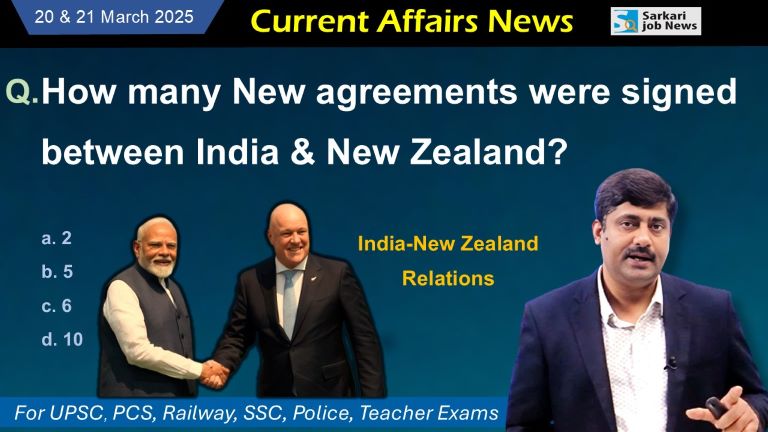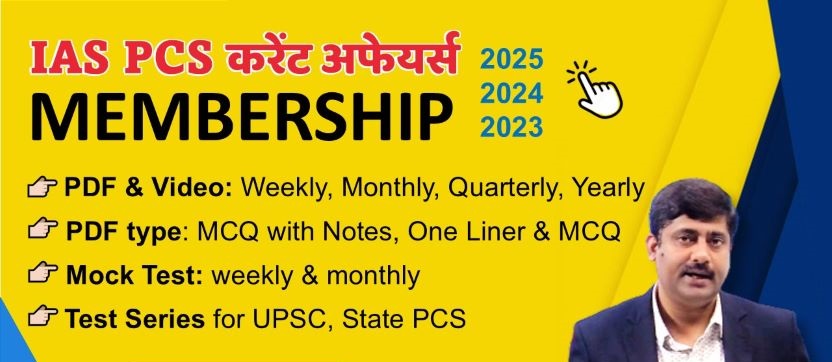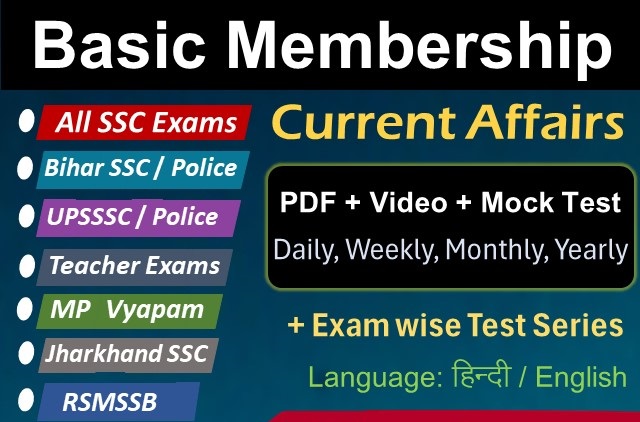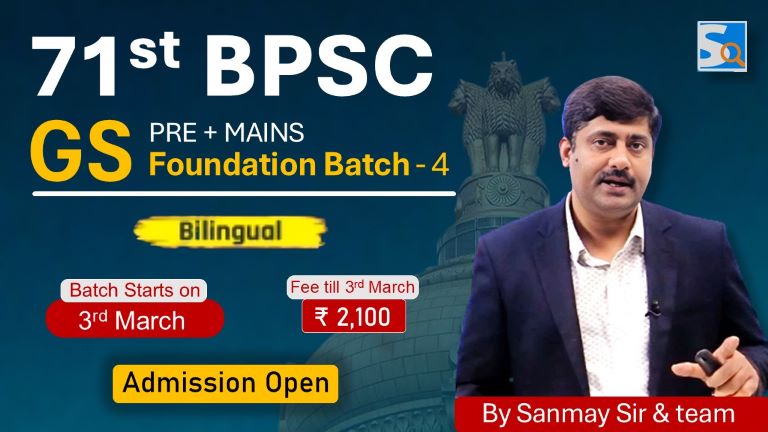This is the current affairs of 20 & 21 March 2025. Here are questions and answers of daily current affairs for better preparation of competitive exams for government jobs.
PDF Download: Click here
1. Which Artificial Intelligence (AI) chatbot responded to an abusive provocation with equal abuse, prompting the Central Government to initiate informal dialogue with social media platform ‘X’?
a. Grok
b. ChatGPT
c. Gemini
d. DeepSeek
Answer: a. Grok

– The generative AI chatbot ‘Grok’ on the social media platform ‘X’ (formerly Twitter), owned by Elon Musk, is in the news.
– This chatbot is openly answering sharp political questions and responding to provocative remarks filled with profanity in the same manner.
– According to the newspaper ‘The Hindu,’ the central government has taken notice of this, and an official from the social media platform had an “informal discussion” on the matter.
– The official stated that no notice has been sent to X, but requested anonymity in order to discuss the matter openly.
Grok is more responsive compared to other chatbots:
– Gemini and ChatGPT generally refuse to answer heated political or religious questions or give diplomatic responses.
– However, Grok has taken a different approach.
– Liberal users have happily asked Grok for opinions about right-wing personalities on X and asked politically charged questions.
– In various languages and with different levels of faith, the chatbot has responded without hesitation.
– Users have also expressed surprise at Grok’s ability to answer in the Romanized versions of Hindi, Telugu, Tamil, and other Indian languages, which mimic the casual style of such conversations, while also code-switching in English.
What action has the central government taken?
– The newspaper ‘The Hindu’ wrote that an official said the government’s objection this time is primarily regarding the offensive language being circulated online by Grok. The official stated, “We are investigating whether any law has been violated, and after that, we will see what action is required.”
—-
X has filed a lawsuit against the central government for allegations of censorship and violation of the IT Act:
– X has filed a lawsuit in the Karnataka High Court.
– X claims that the government is bypassing the Supreme Court’s safeguards by issuing blocking orders under Section 79 of the IT Act.
– X stated that the central government is illegally delegating blocking powers to local police through the Ministry of Home Affairs’ cooperation portal.
————–
2. How many agreements were signed during the visit of New Zealand PM Christopher Luxon to India in March 2025?
a. 2
b. 5
c. 6
d. 10
Answer: c. 6 (Education, Sports, Agriculture, Climate Change, Customs and Environment)
– PM Luxon, who arrived as the Chief Guest at the Raisina Dialogue 2025 in India, signed these agreements with India.
– Along with this, negotiations began on a Free Trade Agreement (FTA) between India and New Zealand.

6 New Agreements between India and New Zealand:
1. Memorandum of Understanding (MoU) on defense cooperation between India’s Ministry of Defense and New Zealand’s Ministry of Defense.
2. Authorized Economic Operator – Mutual Recognition Agreement (AEO-MRA) between India’s Central Board of Indirect Taxes and Customs (CBIC) and New Zealand Customs Service.
3. Memorandum of Understanding (MoU) on horticultural cooperation between India’s Ministry of Agriculture and Farmers’ Welfare and New Zealand’s Ministry of Primary Industries.
4. Letter of Intent on forestry cooperation between India’s Ministry of Environment, Forest and Climate Change and New Zealand’s Ministry of Primary Industries.
5. Education cooperation agreement between India’s Ministry of Education and New Zealand’s Ministry of Education.
6. Memorandum of Understanding (MoU) on cooperation in sports between India’s Ministry of Youth Affairs and Sports and New Zealand’s Sport New Zealand.
India – New Zealand Relations:
– Bilateral relations between India and New Zealand are based on friendship, trade, cultural exchange, and global cooperation. Diplomatic relations between the two countries were established in 1952.
Economic and Trade Relations:
– In the 2023-24 financial year, the bilateral trade between India and New Zealand was valued at $1.75 billion USD.
– India exported products worth $682 million to New Zealand, while imports from New Zealand amounted to $369 million.
– Both countries have resumed negotiations on a Free Trade Agreement (FTA), aiming to increase bilateral trade tenfold in the next decade.
Cultural and Educational Relations:
– Around 8,000 Indian students are studying in various fields in New Zealand, strengthening the educational ties between the two countries.
– Additionally, Indian festivals such as Diwali, Holi, Baisakhi, and Onam are enthusiastically celebrated by the Indian community in New Zealand, further deepening the cultural connections.
Sports and Tourism:
– There are close ties between the two countries in the field of cricket.
– New Zealand’s mountaineer Sir Edmund Hillary is especially esteemed in India, symbolizing the relationship in the field of mountaineering.
New Zealand:
– New Zealand is an island country located in the southwestern Pacific Ocean.
– Capital: Wellington
– PM: Christopher Luxon
– Currency: New Zealand Dollar
—————
3. Which country became the new member of the Indo-Pacific Oceans Initiative (IPOI) in March 2025?
a. Canada
b. South Sudan
c. New Zealand
d. None of these
Answer: c. New Zealand
– New Zealand joined the Indo-Pacific Oceans Initiative (IPOI) in March 2025. This announcement was made by PM Narendra Modi and New Zealand’s PM Christopher Luxon. The announcement was made when PM Luxon arrived as the Chief Guest at the Raisina Dialogue 2025 in India.
About the Indo-Pacific Oceans Initiative (IPOI):
– The Indo-Pacific Oceans Initiative (IPOI) was launched by India’s Prime Minister Narendra Modi on November 4, 2019, during the East Asia Summit (EAS) held in Bangkok, Thailand.
– The aim of this initiative is to promote maritime cooperation and security in the Indo-Pacific region.
Partner Countries of IPOI:
– Along with India, major countries like Australia, Japan, France, Indonesia, Thailand, and Vietnam are active partners in this initiative.
– On March 17, 2025, New Zealand also became a partner.
Importance of IPOI:
– It is part of India’s strategy to ensure an “open, inclusive, and rules-based” Indo-Pacific region.
– It is also seen as a diplomatic effort to balance China’s aggressive maritime claims.
– It promotes regional cooperation and contributes to economic development, environmental protection, and security.
– The IPOI is a significant initiative by India to ensure cooperation, peace, and sustainable development in the Indo-Pacific region.
– Through this, India is also advancing its “SAGAR” (Security and Growth for All in the Region) principle.
Main Objectives of the Indo-Pacific Oceans Initiative (IPOI):
1. Maritime Security – To maintain peace, stability, and a rule-based order in the region.
2. Maritime Transport and Connectivity – To ensure safe and efficient maritime routes for trade and movement.
3. Marine Environment and Resource Management – To preserve the ocean’s ecology and promote sustainable development.
4. Capacity Building and Resource Sharing – To enhance technical and research cooperation among member countries.
5. Disaster Risk Reduction and Management – To develop disaster prevention and rapid response capabilities.
6. Sustainable Fisheries – To make fisheries scientific and sustainable.
7. Scientific Research and Educational Collaboration – To promote marine science and innovation.
————–
4. Which country became the new member of the Coalition for Disaster Resilient Infrastructure (CDRI) in March 2025?
a. Canada
b. South Sudan
c. New Zealand
d. None of these
Answer: c. New Zealand
– The Coalition for Disaster Resilient Infrastructure (CDRI) is an international coalition launched by India in 2019 during the United Nations Climate Action Summit.
– Its aim is to promote disaster-resilient infrastructure globally and take concrete steps to protect against climate change and disasters.
Objectives of CDRI:
– Development of Disaster-Resilient Infrastructure: To build safe and sustainable infrastructure that can withstand natural disasters (earthquakes, floods, cyclones, etc.).
– Technical and Financial Cooperation: To facilitate the exchange of knowledge, technology, and financial resources among member countries.
– Collaboration in Policy-Making: To enhance collaboration between governments, the private sector, academic institutions, and international organizations.
– Addressing Climate Change: To prioritize climate-resilient infrastructure.
Member Countries and Organizations of CDRI:
– Currently, CDRI has more than 39 member countries and organizations, including the United States, United Kingdom, Japan, France, Germany, Australia, Canada, Italy, Argentina, Bangladesh, Bhutan, Fiji, Maldives, Sri Lanka, and others.
– Major organizations such as the United Nations Development Programme (UNDP), the World Bank, and the Asian Development Bank (ADB) are also CDRI’s partners.
Key Initiatives and Achievements:
– The “Infrastructure for Resilient Island States (IRIS)” initiative was launched during the COP26 climate summit in 2021, aimed at providing assistance to small island nations to protect them from disasters.
– In 2023, India launched the “CDRI Fellowship Programme” to promote research and innovation in disaster management.
– CDRI is working towards achieving the objectives of the Sendai Framework for Disaster Risk Reduction (2015-2030).
Importance of CDRI:
– In light of the increasing frequency of disasters due to climate change, developing safe and sustainable infrastructure has become essential.
– It contributes to the achievement of global Sustainable Development Goals (SDGs).
– CDRI plays an important role in G20 and COP (Conference of Parties) climate summits.
————–
5. When is the Global Recycling Day celebrated?
a. 16 March
b. 17 March
c. 18 March
d. 19 March
Answer: c. 18 March
Theme 2025
– #RecyclingHeroes
What is Recycling:
– It is primarily the process of making used items reusable or converting them into eco-friendly elements.
– It involves converting recyclable waste materials back into raw materials that can be used to create new products.
– The goal is to keep waste out of landfills. These materials are then used to make new items or products. Recycling has three main stages: collecting waste materials, converting them into new products, and purchasing those products so they can be recycled later.
————-
6. A peace treaty was agreed between which two countries to end the Nagorno-Karabakh conflict?
a. Armenia and Azerbaijan
b. Russia and Azerbaijan
c. Armenia and Russia
d. Azerbaijan and Türkiye
Answer: a. Armenia and Azerbaijan
– The two countries of the South Caucasus, Armenia and Azerbaijan, have agreed to a peace treaty to end their four-decade-long enmity. The agreement was reached on March 13, 2025.
The Matter:
– The Nagorno-Karabakh conflict began in the late 1980s.
– Nagorno-Karabakh is a mountainous region in the Caucasus, surrounded by land between the Black Sea and the Caspian Sea.
– It is internationally recognized as part of Azerbaijan, but its population is primarily ethnically Armenian.
– It has its own government, which has close ties with Armenia, but it is not officially recognized by Armenia or any other country.
– Since the declaration of independence from Azerbaijan following the collapse of the Soviet Union in the late 1980s, the Nagorno-Karabakh conflict has been ongoing.
– The first war between Armenia and Azerbaijan over this region occurred in the late 1980s.
– This war ended in 1994 with a ceasefire, after which Nagorno-Karabakh and some surrounding areas came under Armenian control.
– Both sides repeatedly violated this ceasefire, and several attempts at negotiations for a peaceful resolution have failed.
– In 2020, Azerbaijan launched a second war, regaining control of one-third of Nagorno-Karabakh.
– After the second Nagorno-Karabakh war in 2020, Russia mediated a peace agreement, following which the deployment of Russian forces in the region was approved.
Difficulties in the Peace Agreement:
– However, Azerbaijan’s condition for the agreement includes a demand for amendments to Armenia’s constitution.
– Armenia denies such claims, but Prime Minister Nikol Pashinyan has repeatedly stated that changes to the country’s founding documents are necessary.
– He has called for a referendum on this issue, but no date has been set yet.
Azerbaijan:
– Prime Minister: Ali Asadov
– President: Ilham Aliyev
– Capital: Baku
– Population: 10.2 million (2023)
– Currency: Azerbaijani Manat
– Neighboring Countries: Russia, Georgia, Iran, Armenia, and Turkey
Armenia:
– Prime Minister: Nikol Pashinyan
– President: Vahagn Khachaturyan
– Capital: Yerevan
– Population: 2.99 million (2023)
– Currency: Dram
– Neighboring Countries: Georgia, Azerbaijan, Turkey, and Iran
————-
7. When is Ordnance Factories’ Day celebrated?
a. 16 March
b. 17 March
c. 18 March
d. 19 March
Answer: c. 18 March
– India’s oldest armament factory is located in Koshipur, Kolkata.
– Production at this factory began on March 18, 1802.
– This is the reason why this day is celebrated.
Note – The Ordnance Factory Board (Indian Ordnance Factories) has been dissolved by the central government, and seven new Public Sector Undertaking (PSU) companies have been created.
————-
8. According to the report of Association of Democratic Reforms (ADR), an NGO working on electoral reforms, how many percent of the country’s MLAs have criminal cases registered against them?
a. 40%
b. 45%
c. 50%
d. 55%
Answer: b. 45%
– ADR analyzed the electoral affidavits of 4092 out of 4123 legislators from 28 states and three union territories with legislative assemblies in the country.
– In Andhra Pradesh, the highest number of legislators, 138 out of 174 (79%), declared criminal cases against themselves, while in Sikkim, the lowest number, only one legislator (3%) out of 32, declared criminal cases against themselves.
– The report revealed that 1861 legislators declared that they have criminal cases against them.
– Among them, 1205 face serious charges like murder, attempt to murder, kidnapping, and crimes against women.
– The analysis of 24 legislators couldn’t be done due to poor scanning.
– Additionally, seven seats in the assemblies are vacant.
– Among BJP’s 1,653 legislators, 39% or 638 have declared criminal cases against themselves, of which 436 (26%) face serious charges.
– Among Congress’s 646 legislators, 339 (52%) declared criminal cases, with 194 (30%) facing serious charges.
– The highest proportion of legislators facing criminal cases is from the Telugu Desam Party (TDP).
– Of its 134 legislators, 115 have declared criminal cases against themselves, with 82 facing serious charges.
– In Tamil Nadu’s ruling Dravida Munnetra Kazhagam (DMK), 74% (98 out of 132) legislators have criminal cases against them, with 42 facing serious charges.
127 Legislators with Crimes Related to Women:
– According to the report, 54 legislators face charges under Section 302 of the Indian Penal Code (IPC) for murder.
– 226 face charges under Section 307 of IPC and Section 109 of the Indian Penal Code (BNS) for attempt to murder.
– Additionally, 127 legislators face charges for crimes against women.
– Among them, 13 are accused under IPC Sections 376 and 376 (2)(n) for rape.
– Section 376 (2)(n) relates to repeated sexual harassment of the same victim.
—————
9. According to the report of NGO Association of Democratic Reforms (ADR), who is the richest Chief Minister of the country?
a. Devendra Fadnavis
b. Chandrababu Naidu
c. Pema Khandu
d. mk stalin
Answer: b. Chandrababu Naidu
– A report released on December 30, 2024, revealed that Andhra Pradesh’s Chief Minister, N. Chandrababu Naidu, is the richest Chief Minister in the country.
– He has assets worth more than ₹931 crore.
– According to the report, while India’s per capita Net National Income (NNI) in 2023-2024 was about ₹1,85,854, the average income of a Chief Minister was ₹13,64,310.
– This is about 7.3 times higher than India’s average per capita income.
– The average wealth of the Chief Ministers of 31 states and union territories is ₹52.59 crore.
– While the total wealth is ₹1,630 crore.
– Meanwhile, West Bengal’s Chief Minister Mamata Banerjee is the poorest, with assets worth ₹15 lakh.
BJP Receives ₹4340.47 Crore in Donations in One Year:
– ADR released a report on February 17, 2025, regarding the donations received by national parties.
– According to the report, in the financial year 2023-24, BJP received the highest donations amounting to ₹4340.47 crore.
– Congress was second, receiving ₹1225.12 crore.
– The report stated that a major portion of the donations for the parties came from electoral bonds.
– BJP spent 50.96% of its earnings, amounting to ₹2211.69 crore, while Congress spent 83.69% of its income, amounting to ₹1025.25 crore.
– The Aam Aadmi Party (AAP) received ₹22.68 crore in donations, but the party spent ₹34.09 crore, which was more than its donations.
– BJP received 74.57% of the total donations received by all parties, while the remaining five parties received 25.43% of the donations.
—————
10. When is World Sparrow Day celebrated?
a. 17 March
b. 18 March
c. 19 March
d. 20 March
Answer: d. 20 March
– This day is celebrated to raise awareness about sparrows and their conservation.
– The population of sparrows has decreased due to various reasons, including increasing pollution.
– World Sparrow Day is an initiative started by the Nature Forever Society of India, along with France’s EcoSages Action Foundation.
– The first World Sparrow Day was celebrated on March 20, 2010.
—————
11. When is International Happiness Day celebrated?
a. 19 March
b. 20 March
c. 21 March
d. 22 March
Answer: b. 20 March
Theme 2025
– Caring and Sharing
– The day was declared by the United Nations recognising the importance of happiness and well-being in promoting sustainable development and global peace.
————-
12. Cannes Best Actress Award winner Emily Dequenne passed away on 16 March 2025, in which year did she receive this award?
a. 1991
b. 1995
c. 1997
d. 1999
Answer: d. 1999
– 43-year-old Emilie Dequenne of Belgium was suffering from a rare gland cancer.
– She won the Best Actress award at Cannes in 1999 for her first film Rosetta.
– The actress got her first role in the film ‘Rosetta’ at the age of 17.




